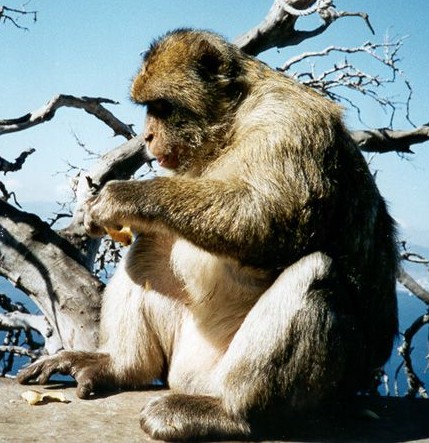|
| Query: apes and monkeys | Result: 9th of 48 | |
Barbary Macaque (Macaca sylvanus) - Wiki
| Subject: | Barbary Macaque (Macaca sylvanus) - Wiki
| |

| Resolution: 429x443
File Size: 74075 Bytes
Upload Date: 2007:10:06 20:40:55
|
Barbary Macaque
From Wikipedia, the free encyclopedia
[Photo] Barbary Macaque (Macaca sylvanus). Source: http://www.nal.usda.gov/awic/pubs/primates/primphot.htm Photographer: Mary Lassanyi. License: public domain
The Barbary Macaque (Macaca sylvanus) is a tail-less macaque. Found in the Atlas Mountains of Algeria and Morocco with a small, possibly introduced, population in Gibraltar, the Barbary Macaque is one of the best-known Old World monkey species. Besides humans, they are the only primates that live freely in Europe. Although the species is commonly referred to as the "Barbary Ape", the Barbary Macaque is a true monkey, not an ape. Confusion as to the name could have arisen from the fact that apes are tailless, as is the Barbary Macaque.
Appearance
This monkey is yellowish-brown to grey with lighter undersides, growing to a maximum size of 75 cm (30 in) and 13 kg (29 lb). Its face is a dark pink and its tail is vestigial. The front limbs of this monkey are longer than its hind limbs. Females are somewhat smaller than males.
Ecology
Dwelling in forests of cedar, pine and oak, the Barbary Macaque may frequent elevations of 2,100 m (6,900 ft) or more. It is a diurnal animal, dividing its time more or less equally between arboreal and terrestrial territory. Mostly herbivorous, this monkey feeds on leaves, roots, and fruit, but will also eat insects. By day, the Barbary Macaque patrols a territory which may span several square kilometers; it peacefully co-exists with other primate species, sharing watering holes without incident. The Barbary Macaque moves about energetically on all fours, occasionally rising erect on its hind limbs to survey for threats.
The Barbary Macaque is a gregarious monkey, forming mixed groups of several females and males; the troop of 10 to 30 individuals is matriarchal, with its hierarchy determined by lineage to the lead female. Unlike other macaques, the males participate in rearing the young; much time is spent playing and grooming with them. In this way, a strong social bond is formed between a male and his offspring, both the male's own and those of others in the troop. This may be a result of selectiveness on the part of the females, who seem to prefer highly parental males.
The mating season runs from November through March. After a gestation period of 147 to 192 days, typically one baby per female is born; twins are a rarity. The monkeys reach maturity at 3 to 4 years of age, and may live for 20 years or more.
Status
The habitat of the Barbary Macaque is under threat from increased logging activity; they are listed as vulnerable by the IUCN Red List. Local farmers see the monkeys as pests worthy of extermination. Once common throughout northern Africa and southern Europe, there are estimated to be just 1,200 to 2,000 Barbary Macaques left.
Human use
Many of the mistaken ideas about human physiology contained in the writings of Galen are apparently due to his use of these animals, the anthropoid available to him, in dissections. Strong cultural taboos of his era prevented his performing any actual dissections of human cadavers, even in his role as physician and teacher of physicians.
Gibraltar population
The last wild population in Europe is that of Gibraltar, which unlike that of North Africa is thriving. At present there are some 230 animals in five troops occupying the area of the Upper Rock, though occasional forays into the town result in monkey mayhem.
http://en.wikipedia.org/wiki/Barbary_Macaque
| The text in this page is based on the copyrighted Wikipedia article shown in above URL. It is used under the GNU Free Documentation License. You may redistribute it, verbatim or modified, providing that you comply with the terms of the GFDL. |
|
Comments |
|---|
| | Guest |
|
Scientific Name: Macaca sylvanus (Linnaeus, 1758)
Common Names:
English – Barbary Macaque, Barbary Ape, Magot
French – Magot commun, Macaque de Gibraltar, Magot
Spanish – Mona de Berbería, Mona de Gibraltar, Mono de Berberea, Mono de Gibraltar
Synonyms:
Macaca sylvana (Linnaeus, 1758) [orth. error]
Simia sylvanus Linnaeus, 1758
Inuus ecaudatus É. Geoffroy Saint-Hilaire, 1812
Simia inuus Linnaeus, 1766
Simia pithecus Schreber, 1799
Pithecus pygmaeus Reichenbach, 1863 |
^o^
Animal Pictures Archive for smart phones
^o^
|
|
|